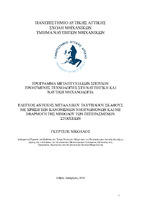| dc.contributor.advisor | Θεοδουλίδης, Αλέξανδρος | |
| dc.contributor.author | Γκέρτσος, Νικόλαος | |
| dc.date.accessioned | 2021-04-04T08:23:45Z | |
| dc.date.available | 2021-04-04T08:23:45Z | |
| dc.date.issued | 2021-01-25 | |
| dc.identifier.uri | https://polynoe.lib.uniwa.gr/xmlui/handle/11400/536 | |
| dc.identifier.uri | http://dx.doi.org/10.26265/polynoe-387 | |
| dc.description.abstract | Στην παρούσα εργασία θα εξετάσουμε την αντοχή της μεταλλικής κατασκευής ενός αλουμινένιου ταχύπλοου σκάφους πλαναρίσματος με χρήση των κανονισμών των νηογνωμόνων (DNV GL) καθώς και με εφαρμογή της μεθόδου των πεπερασμένων στοιχείων (Finite Element Analysis). Η ιδιαιτερότητα υπολογισμού της αντοχής στα ταχύπλοα σκάφη εμφανίζεται στην γεωμετρία της γάστρας. Η μορφή της γάστρας θέτει όλους τους περιορισμούς κατά τις διάφορες φάσεις της σχεδίασης. Λαμβάνοντας υπόψιν αυτό καταλαβαίνουμε πως είναι δύσκολο να υπάρχει μια συγκεκριμένη γενική μεθοδολογία που να καλύπτει ακριβώς τις απαιτήσεις του κάθε σκάφους. Αυτό έχει σαν αποτέλεσμα σε πολλές περιπτώσεις οι κανονισμοί των νηογνωμόνων να οδηγούν σε υπερδιαστασιολόγηση των κύριων στοιχείων της μεταλλικής κατασκευής του σκάφους. Η σημασία της έρευνας αυτής είναι η περαιτέρω μελέτη της αντοχής τέτοιου είδους σκαφών με νέες μεθόδους. Ως γνωστών η επιλογή των δομικών στοιχείων ενός σκάφους γίνεται με επαναληπτική διαδικασία, για την εύρεση του βέλτιστου συνδυασμού μορφής-πάχους. Με τη βοήθεια των πεπερασμένων στοιχείων θέτουμε έναν νέο στόχο στην εύρεση του κατάλληλου δομικού στοιχείου έχοντας ένα συγκεκριμένο μοντέλο που αφορά μόνο το υπό εξέταση σκάφος. Ο σκοπός της μελέτης αυτής είναι η καταγραφή των αποτελεσμάτων των δυο μεθόδων, η ορθή ερμηνεία των αποτελεσμάτων των πεπερασμένων στοιχείων, καθώς γίνονται διάφορες υποθέσεις στο κομμάτι της προετοιμασίας του μοντέλου, και τέλος η δυνατότητα βελτίωσης της κατασκευής με τη μέθοδο των πεπερασμένων στοιχείων. | el |
| dc.format.extent | 123 | el |
| dc.language.iso | el | el |
| dc.publisher | Πανεπιστήμιο Δυτικής Αττικής | el |
| dc.rights | Αναφορά Δημιουργού - Μη Εμπορική Χρήση - Παρόμοια Διανομή 4.0 Διεθνές | * |
| dc.rights | Attribution-NonCommercial-NoDerivatives 4.0 Διεθνές | * |
| dc.rights | Attribution-NonCommercial-NoDerivatives 4.0 Διεθνές | * |
| dc.rights.uri | http://creativecommons.org/licenses/by-nc-nd/4.0/ | * |
| dc.subject | Αντοχή | el |
| dc.subject | Νηογνώμονας | el |
| dc.subject | Αλουμίνιο | el |
| dc.subject | Ταχύπλοο | el |
| dc.subject | Σκάφος | el |
| dc.subject | Ansys | el |
| dc.subject | DNV | el |
| dc.subject | Aluminum | el |
| dc.subject | High-Speed | el |
| dc.subject | Craft | el |
| dc.subject | Πεπερασμένα στοιχεία | el |
| dc.subject | Structural design | el |
| dc.subject | Classification society | el |
| dc.subject | FEA analysis | el |
| dc.title | Έλεγχος αντοχής μεταλλικού ταχυπλόου σκάφους με χρήση των Κανονισμών Νηογνωμόνων και με εφαρμογή της Μεθόδου των Πεπερασμένων Στοιχείων | el |
| dc.title.alternative | Structural design of aluminum high speed craft according to Classification Society Rules and Finite Element Analysis | el |
| dc.type | Μεταπτυχιακή διπλωματική εργασία | el |
| dc.contributor.committee | Πολίτης, Κωνσταντίνος | |
| dc.contributor.committee | Δημητρέλλου, Σωτηρία | |
| dc.contributor.faculty | Σχολή Μηχανικών | el |
| dc.contributor.department | Τμήμα Ναυπηγών Μηχανικών | el |
| dc.contributor.master | Προηγμένες Τεχνολογίες στη Ναυπηγική και Ναυτική Μηχανολογία | el |
| dc.description.abstracttranslated | Τhis thesis discusses the structural design of an aluminum high-speed planning craft with rules of classification society and with Finite element analysis.
Aluminum is widely used as a construction material because of its intrinsic properties of lightness and corrosion resistance. Pure aluminum is low-strength metal but thanks to the addition of alloying elements it changes its physical and mechanical properties to meet requirements of a large number of applications.
The hull shape sets all the constraints during the design stages and makes this kind of crafts unique as far as structural calculation in concerned. Having that in mind, it is difficult to have one general methodology which meets the specific requirements of every craft and as a result, the rules of classification societies oversize main structural members of the crafts. For this reason, the use of finite element analysis will be used to check the hull construction in further detail. A breakdown of the finite element analysis and its steps through the post-processing can be found on section 2 with a special reference to the inertia relief BC. Next, the basic concept for the structural design-limit pressures will be mentioned and subsequently the general concept which will be followed during the calculations for the classification society. All the structural calculations will be performed using DNVGL High Speed Light Craft rules. The selection of a structural member of a craft is done with an iterative process, to find the optimal shape-thickness combination. After that, the whole craft will be modeled in Rhinoceros and the surface model will then be imported in ANSYS.
The main purpose of this study is to record the results of the two methods and analyze the possibility of improving the construction. The outcome of this thesis is a fairly good optimization of the construction as we can reduce the thickness of 2 main shell plates (bottom, side). The main girder system of the bottom hull has low stresses and as a result it could be downscaled and gain more clear height inside the craft. The bottom secondary longitudinal stiffeners stresses are acceptable even though the brackets have not been modeled. Having a construction with no brackets keeps the heat affected zone from welding in low levels and also minimizing labor cost. In conclusion, FEA reveals local stress concentration areas contrary to the calculations performed by the rules.
Summing up all the above the final weight of the craft will be significantly less than that calculated by the rules. This gives a great advantage in this type of crafts which could be a bigger payload capability or a higher top speed. | el |


